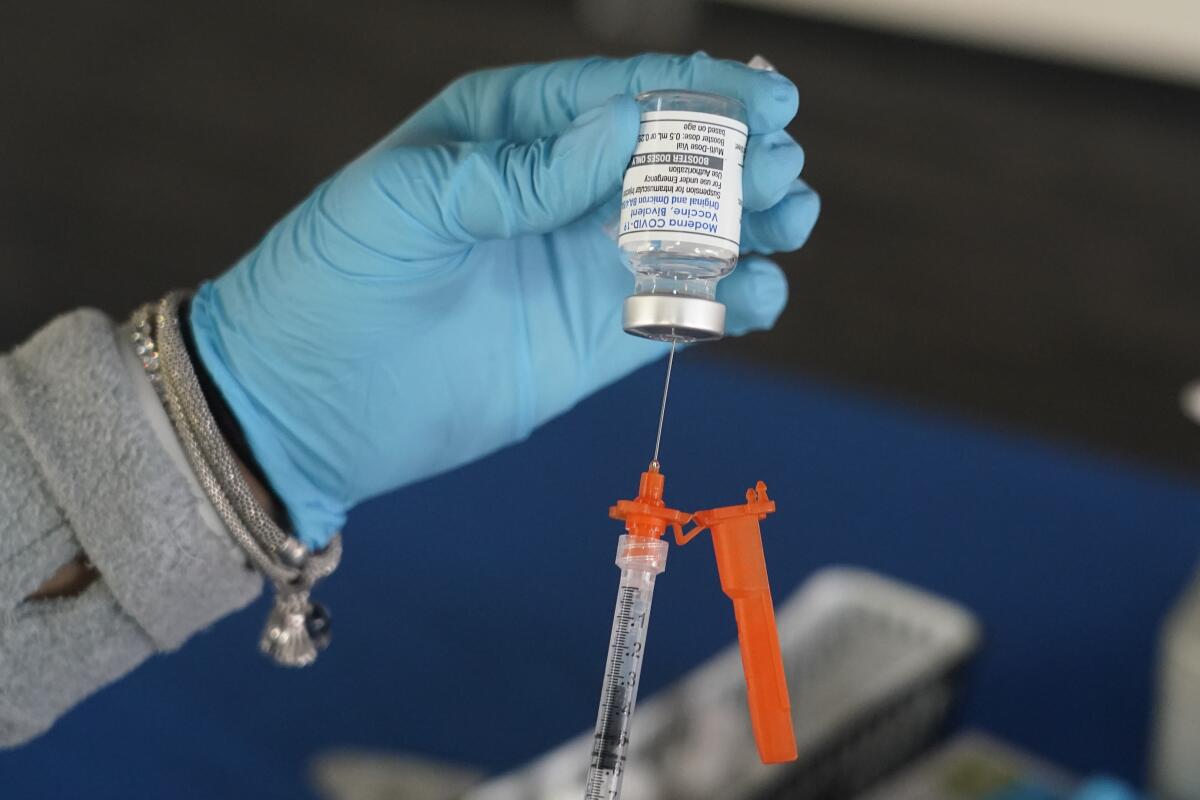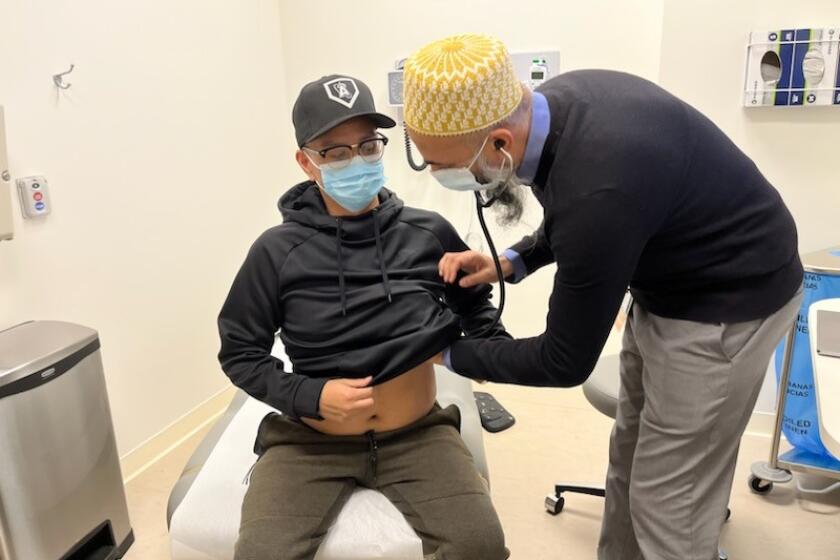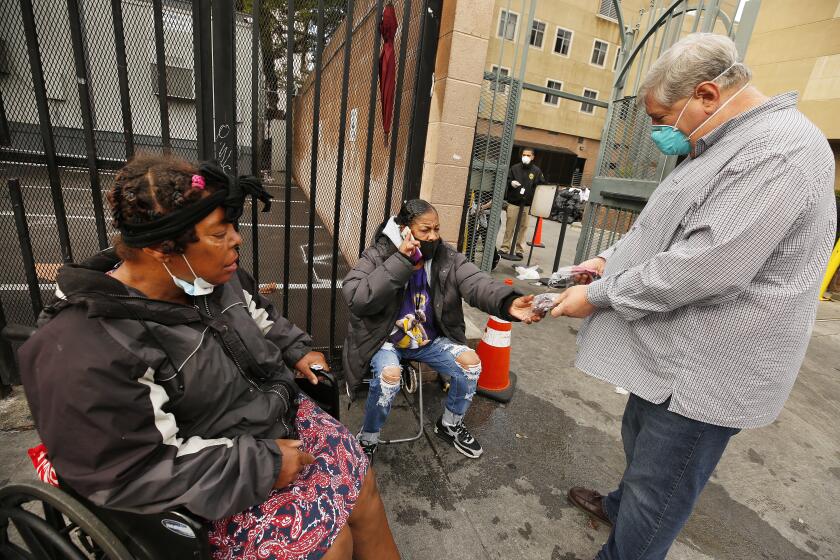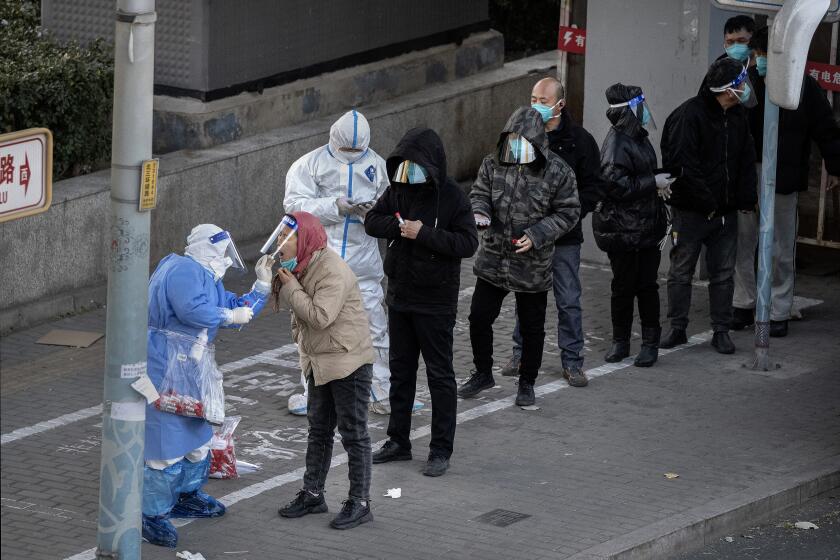As COVID-19 spikes in California, booster shots could make all the difference

With coronavirus cases and hospitalizations rising in Los Angeles County, officials are voicing new confidence in the effectiveness of the updated COVID-19 booster shot.
New data has found that the updated COVID-19 vaccines offer “significant additional protection” against symptomatic infection in people who were previously vaccinated or boosted with the older formula.
While the efficacy of the shots varied depending on a person’s vaccine history, data published in a recent U.S. Centers for Disease Control and Prevention Morbidity and Mortality Weekly Report found consistently boosted defense across all adult age groups.
“Everybody was asking the question, ‘Where’s the clinical efficacy data?’ Now it has come out with the CDC [report],” Dr. Anthony Fauci, President Biden’s outgoing chief medical advisor for the pandemic, said at a briefing before Thanksgiving. “We know that it is effective.”
For those ages 18 to 49 who had gone at least eight months since their last vaccine dose, the new shot increased protection by 56%, according to the report. For adults in this age group who got the older vaccine in the past two to three months and then got the updated booster, relative effectiveness was 30%.
The same held true for older adults. For those ages 50 to 64 who had gotten vaccinated in the past few months, the new shots increased protection by 31% — with that figure growing to 48% if they were at least eight months out from their last dose, the report said. For older seniors, those figures were 28% and 43%, respectively.
Americans who have gotten the updated COVID boosters appear better protected against symptomatic infection than those who haven’t — at least for now.
The newest version of the vaccine, which has been available since September, offers protection against the ancestral coronavirus strain as well as the more recently circulating Omicron subvariants, including BA.4 and the long-dominant BA.5.
That’s why it’s known as the bivalent booster, which distinguishes it from the older monovalent vaccine that was designed only against the original strain. The process of altering the formula was similar to how the flu shot is updated annually.
At the time the boosters were released, many experts endorsed them, noting that tests on animals showed a good immune response. But some were concerned about the lack of clinical data showing their effectiveness in humans.
“If you look at the recent data that has now been coming out from the [vaccine] companies as well as academic investigators, it is clear now — despite [an] initial bit of confusion — that … the updated vaccine clearly induces a better response against BA.4/5, and the sublineages of BA.4/5, than does the ancestral strain,” Fauci said. “It looks quite good.”
The updated booster is available for those 5 and older who are at least two months out from their last shot.
When everyone around them stops taking pandemic precautions, it gets harder for immunocompromised Americans to protect themselves against COVID.
However, while the share of those rolling up their sleeves is growing steadily, progress has been slow. In California, 18.3% of the state’s 28.7 million eligible residents have gotten the bivalent booster — a far cry from the more than 72% who have completed their primary series.
“We have seen very low uptake of the bivalent booster,” California Health and Human Services Secretary Dr. Mark Ghaly said recently. “I know I have conversations every day with Californians asking whether they should get it, whether now is the right time. And it’s a resounding yes.”
In Los Angeles County, about 1.1 million residents 12 and older have received the updated booster, about 15% of the 7.16 million who are eligible for the shot.
Officials are urging people to get the updated shot, especially seniors and other vulnerable people. Coronavirus cases in L.A. County have more than tripled since their autumn low, rising to 3,053 new cases a day for the seven-day period that ended Friday.
On a per capita basis, that’s 212 weekly cases for every 100,000 residents. A rate of 100 or more is considered high.
The San Francisco Bay Area is also experiencing a surge in cases, including among employees of UC San Francisco, who are getting infected in the community rather than at work.
“We see a really strong rise here,” Dr. Ralph Gonzales, a UC San Francisco associate dean, said at a recent town hall.
Since Sept. 5, only 1 in 100 UC San Francisco workers and students who have gotten the updated booster have since been infected with the coronavirus. But among those who haven’t been boosted with the updated shot, about 1 in 20 have been infected, according to Gonzales.
“So I want to encourage the bivalent booster because we are seeing that it shows quite good protection, at least so far,” he said.
Dr. Robert Wachter, chair of UC San Francisco’s Department of Medicine, tweeted Friday that 5% of patients at the campus who have no symptoms are testing positive for the coronavirus, up from 2% last month. That suggests that in a crowd of 150 people, say people on an airplane, there’s a 99.9% chance at least one of them is positive for the coronavirus and isn’t aware of it.
New hospitalizations have tripled in the last month. A new mask order is possible in the coming weeks if hospitalization metrics worsen.
Even as coronavirus cases rise, there’s optimism that this winter won’t bring the same devastation as the pandemic’s previous years. That confidence stems from a relatively robust toolbox, which now includes tests, vaccines and treatments.
Residents also can take individual precautions, such as regularly washing their hands, covering their mouths and noses when they cough and sneeze or wearing a mask in crowded or indoor spaces.
“We have COVID vaccines. We have testing. We have the option, under certain circumstances with good judgment, to wear masks where appropriate in indoor congregate settings,” Fauci said. “So we can do a lot to mitigate any surge.”
But the consequences of a lagging booster campaign now could reverberate later. As Ghaly put it, “the result of a low uptake means more pressure on the healthcare delivery system.”
“Now is not too late to get those vaccines — not just to have your personal protection but also support the broader needs, keep our delivery system ready to serve those with other needs beyond respiratory viruses,” he said.
In more recent comments he made Thursday, Ghaly expressed optimism that more people were getting the bivalent booster.
“If you look at just yesterday, we’re nearly 40% higher in the number of [updated boosters] that we’ve calculated were given in California ... than the seven-day average,” Ghaly said in an online talk with the Public Policy Institute of California. “And so what that tells me is Californians are starting to get the message. They’re starting to see the real reality of the threat.”
L.A. County officials are also concerned about a rapid rise in coronavirus-positive hospitalizations. According to the U.S. Centers for Disease Control and Prevention, there were 1,285 new admissions of coronavirus-positive patients in the county for the week that ended Wednesday — more than triple the rate from the beginning of November.
“We feel like we’re seeing a much more rapid acceleration than we want to be seeing at this point,” L.A. County Public Health Director Barbara Ferrer said Thursday. Should hospitalizations continue to rise, there is concern that, at some point, deaths will, too.
The people who are most vulnerable to COVID-19 are unvaccinated, Fauci said. And those who have been vaccinated but still gotten infected and died of COVID-19 are more likely to have not received a booster shot, officials say.
“The science on this is crystal clear: [When] people get their booster, if you get infected, the chances you’re going to end up super sick in the hospital is exceedingly low. That’s the message: People need to get their updated vaccine,” said Dr. Ashish Jha, the White House COVID-19 response coordinator.
Protesters in China are eager to see an easing of “zero-COVID” rules, but health experts warn that doing so could prompt a massive health emergency.
One encouraging sign from outside the U.S. comes from Singapore, which experienced a major wave of new cases associated with the Omicron subvariant XBB.
“They had [an] increase in cases, but they did not have a concomitant major increase in hospitalizations,” Fauci said. “So we’re hoping that a combination of people who’ve been infected and boosted and vaccinated — or people who’ve been vaccinated and boosted and not infected — that there’s enough community protection that we’re not going to see a repeat of what we saw last year at this time.”
All of that assumes there are no other COVID curveballs. This time last year is when Omicron burst onto the scene and shattered hopes that the pandemic was over.
Conditions can always change based on “things out of left field you can’t predict,” Jha said.
“But nothing I have seen in the subvariants makes me believe that we can’t manage our way through it effectively, especially if people step up and get their vaccine,” he said.
Federal officials are still urging Congress to pass a $10-billion COVID-19 pandemic-funding proposal, which has been stalled for months. Jha warned that the U.S. is falling behind other nations in investing in a new generation of COVID-19 vaccines that can better protect against infection through a nasal spray.
“What you have seen is China make a very large investment in mucosal vaccines because they understand that that’s how you deal with respiratory viruses. America is falling behind on this really important technology,” Jha said. “A major part of our request is for funding for public-private partnerships to move those kinds of technologies forward, to move the next generation of treatments forward.”
More to Read
Sign up for Essential California
The most important California stories and recommendations in your inbox every morning.
You may occasionally receive promotional content from the Los Angeles Times.
















